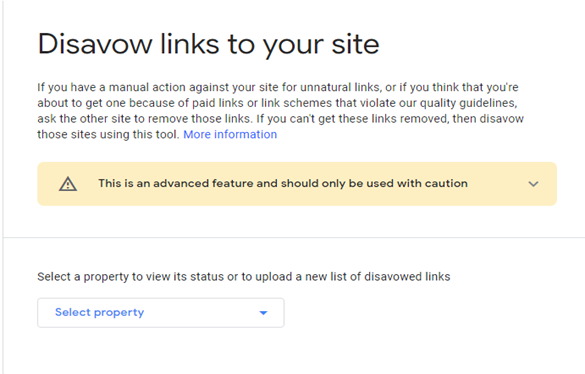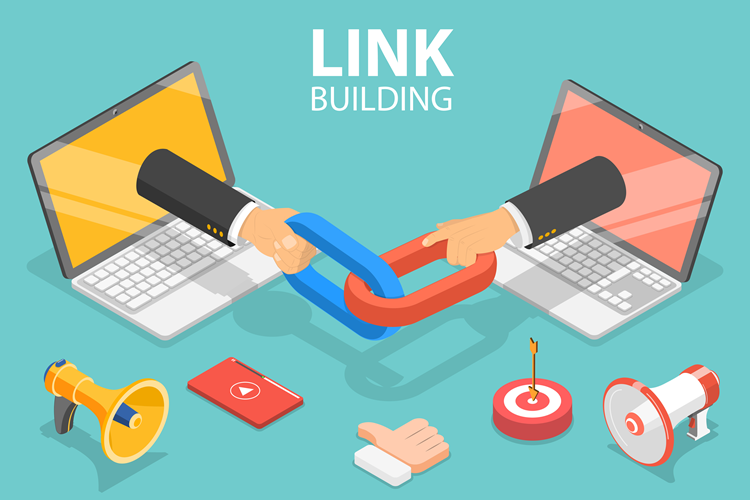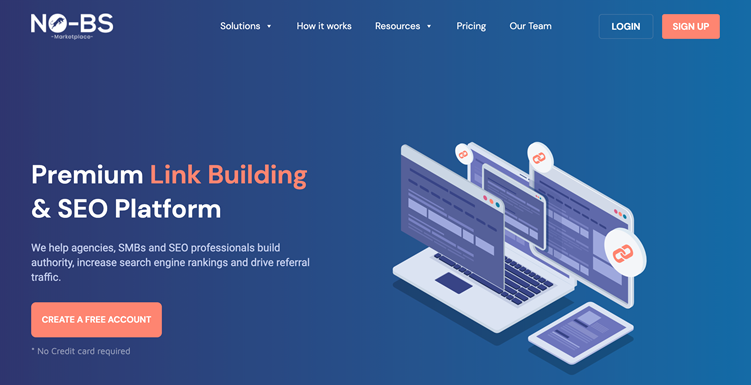Google, Facebook, YouTube, and Twitter are among the most backlinked-to domains in the world. Statistics show that the four most popular brands are the only ones with over 400,000 backlinks.
Of course, these backlinks aren’t the only sources of traffic. However, they’ve certainly contributed to the billions of visits enjoyed by the mentioned websites.
Reaching the heights set by the likes of YouTube is a big ask for any webmaster.
So, how do you create a link building strategy that brings tangible results? This article discusses everything you need to know.
What Does Link Building Entail?
Link building is one of the most popular search engine optimization (SEO) tactics. It’s been around for as long as the internet has existed. But it’s become more prominent in recent years as more people take their businesses online.
It’s worth noting that link building served a different purpose in the pre-Google age. The strategy was used to generate direct traffic to sites rather than manipulating their SEO performance.
Webmasters used Web rings as their main link building tactic. A Web ring refers to an array of websites linked together in a linear loop. A visitor could only move through the chain in one direction from the oldest site to the latest.

This technique has since evolved to a ranking factor. Webmasters use it today to enhance their sites’ position in search engine result pages (SERPs).
In the early 2000s, during Google's early years, the game revolved around link quantity. Having more links was the key to achieving higher rankings on SERPs, regardless of the linking website's relevance and authority.
However, this approach led to widespread misuse as people attempted to boost their sites' SEO rankings. Over the years, Google has refined its algorithm to impose stricter ranking criteria.
Today, the number of backlinks still significantly influences Google's ranking system, but it is no longer the sole determining factor.
It's essential to note that Google maintains transparency about its ranking system, primarily to encourage webmasters to prioritize producing high-quality content over obsessing about their position on SERPs.
Steps To An Effective Link Building Plan
Link building can only bring the desired results when done right. So, how do you create an effective strategy? The whole plan boils down to getting authoritative websites linking back to your blog pages.
The idea of link building is to send readers from the current page to another page that has more information on the subject. Keeping this in mind throughout your project will help you develop a profitable strategy.
That said, here are the main steps for a successful link building plan:
1. Know your audience

The website visitors are the main stakeholders in your link-building project. Therefore, your first order of business should be to define and analyze your ideal visitors. Who’s your website’s target audience? What type of content do they like?
Imagine a site designed for sports and entertainment. Your primary audience will be sports lovers. The best way to engage users in this genre is through trending topics, up-to-date sports news, and matchday videos.
Understanding your target market will help you in your content creation. You’ll know which topics to cover, the best visual representation, and the ideal tone to use in your discussions.
2. List the websites that may appeal to your visitors
Once you know your desired audience, you can make a list of sites that’ll help you reach them. The objective is to tap into the traffic of high-authority sites. Therefore, you’d want to partner with publishers with the same target audience. This way, it’ll be easier to attract their visitors to your website. Remember, the overall profile of sites that link back to you may have a huge impact on your SEO performance. Google can devalue your website’s ranking if it finds many toxic backlinks pointing to it. These are backlinks that come from sites that are either spammy, topically irrelevant, or those sites built with objectives of linking out.
Therefore, you must analyze each website thoroughly before requesting backlinks from them. Unnatural links on your site are a liability as you run the risk of being hit by Google Penguin. Google designed this algorithm to detect links acquired through black hat link building methods. Any site found on the wrong may have its SERPs ranking reduced.
When assessing these websites, consider the quality of their pages, as well as their alignment with your objectives. Your goal is not just to acquire backlinks but to establish valuable connections that enhance your website’s conversion rate and bring in qualified website visitors.
How to get rid of bad links
If you already have toxic backlinks, you’ll need to clean up your profile before launching another link building campaign. But before you start cleaning, you’ll first need to know what makes a bad link. You want to disassociate yourself with links from the following sources:
- Penalized domains
- Unrelated websites
- Private blog networks (PBNs)
- Link farms and link directories
- “Bad neighborhoods” such as pharma, porn, and online gambling unless that’s the primary purpose of your site.
After understanding how toxic links look, you can proceed with the removal process.
Step 1: Identify bad links
Unfortunately, there is no automatic method for identifying all bad links on your site. You’ll have to manually review and process all backlinks using a tool of your choice. Follow these steps if you’re using Ahrefs:
- Type your domain into Ahrefs Site Explorer.
- Click on the “Referring domains” tab on the left of your screen. This will take you to a page showing all domains that link to your site.
- You can use any of the metrics shown on the current page to sort out these domains.
- Go with the “Domain Rating (DR)” metric in this procedure as it gives you an idea of a website’s quality. Click on DR to sort the domains from the lowest rating to the highest (or the other way around).
- The lowest DR doesn’t necessarily point to a spammy link. Sometimes, it might be because the linking site is still new.
- To filter the links further, you’ll need to check the domain name, anchor text, and other indicators that may suggest a spammy link. Domains with foreign languages that don’t fall within your niche may also be toxic to your SEO performance.
Analyze each domain individually and list those failing the test. You can create a CSV file with webmaster contacts for outreach and response tracking.
Step 2: Contact the webmaster
Google recommends that you request the publisher to remove your links from their site before taking another step. Of course, the chances of finding responsive webmasters are minimal. Most spammy websites don’t have the owner’s personal contact information.
If there’s no trace of any contact information on the site, you can use the WHOIS Domain Lookup tool. Needless to say, this could also be a dead end, especially if the publisher doesn’t want to be found. Your objectives here are to establish contact and improve your website's conversion rate by removing toxic links and increasing page views.
Step 3: Submit the Google disavow file
You may be lucky to get a webmaster who is ready to fulfill your request. However, if you don’t find their contact information or don’t get any response from them, then you can use Google’s disavow tool.

Create a list of all the URLs you want to disavow. Attach the list, send it using the tool, and wait for the file to be processed. Remember, use the disavow tool only after a thorough analysis of the links.
Step 4: Create engaging content on your site
Content is a key factor in any link building campaign. Publishing informative pieces on your website will not only attract more traffic but also convince authority sites to link back to you. Stay updated with the latest industry trends to ensure your link-building efforts align with best practices.
When you create engaging posts, other publishers will be happy to refer to them without asking for anything in return. Your audience also won’t stop mentioning them in forums and social media groups.
So, how can you ensure that the high-quality content you create contributes to your link building success? For one, publishing it regularly, preferably weekly, will attract more visitors, increase your website's conversion rate, and engage your audience effectively.
Also, focus on trending topics, especially if your niche demands the same. While at it, try to match your content to that of your desired partner websites. This will make it easier for the publishers to integrate your links into their articles.
Step 5: Request backlinks

Online businesses require the help of influencers at some point, and yours is no exception. One way to measure a successful link building campaign is by the number of authority websites that link back to you.
So, your next order of business should be to request backlinks from the best webmasters in the industry. Here are some of the strategies you can use to earn these links:
- Keep up with the activities of your preferred bloggers: Active participation on a webmaster's blog improves your chances of having your request granted. Regularly comment, like, and share their posts. Contribute meaningfully to discussions with informed solutions rather than generic comments like "nice post." Once you've established a good relationship, send a formal request via email, and patiently await their response.
- Offer something in return: Link building can be more successful when both parties gain from the collaboration. Approach it with a reciprocity mindset. Offer something in return, such as a free product sample in exchange for a review, discount codes for the blogger's audience, or high-quality guest content. This way, both sides benefit, increasing content engagement and traffic to your site.
- Hire a link building agency: Link building is a demanding and time-consuming project. But you can make it more manageable by hiring a team of professionals. Depending on the firm and your needs, this route can be budget-friendly and generally effective. So, what do these professionals offer? Some of the benefits of hiring a link-building company include:
- Their expertise will help you develop a high-quality backlink profile.
- They give you easier access to authoritative publishers.
- Their services can enhance your brand visibility.
- You get high-quality and relevant content for your readers.
- Link-building companies can also advise you on the best SEO tips.
Of course, this option is a little more expensive than the previous methods. However, it gives you a better chance to rank among the best on SERPs.

Conclusion
Link building is a popular strategy in the digital space, favored by many online businesses for its benefits. To get started, understand your audience. Define your target audience and list potential partner websites, avoiding any spammy ones. Create authoritative content to attract partner publishers and retain your ideal audience.
